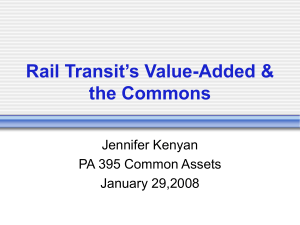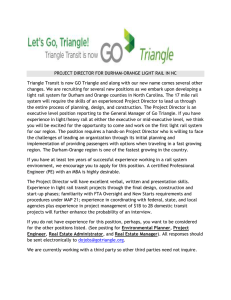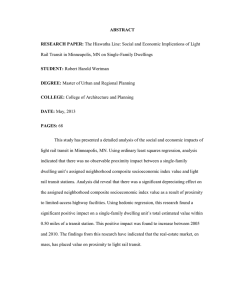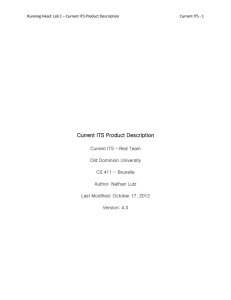12 Lab 1 A look at Current ITS light rail tracking system
advertisement
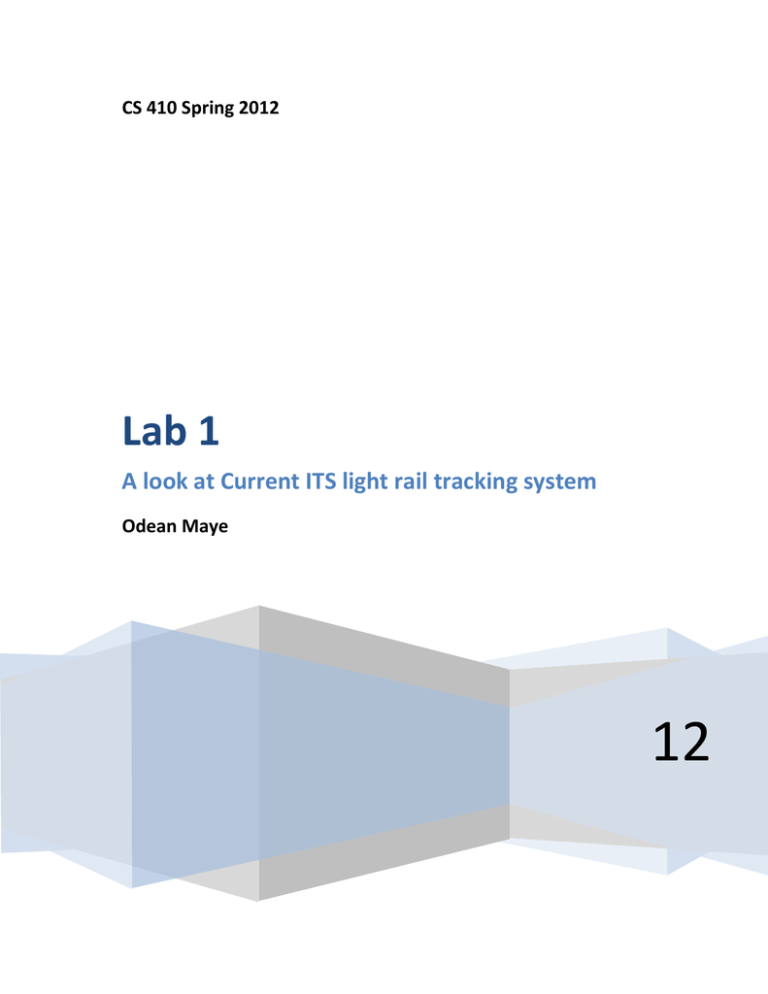
CS 410 Spring 2012 Lab 1 A look at Current ITS light rail tracking system Odean Maye 12 Introduction On August 19th 2011 the first light rail system in Virginia was opened in city of Norfolk. In opening weeks the light rail enjoyed high ridership as Norfolk residents and workers flocked to try out the new service. Studies conducted post opening weeks however have reported a downward trend in the ridership numbers. As a member of the Spring 2012 CS-410 Red Team I have conducted a semesters worth of research on this phenomenon, its causes, and what a possible solution may entail. As a team we have found that the lack of complete and accurate information prevents transit organizations and local businesses from maximizing the potential benefits of light rail systems. More specifically riders demand communication of scheduling information and information pertaining to any local attractions and business around the stops serviced by the light rail. The absence of any such information readily available to them contributes to confusion and frustration among potential riders and ultimately leads to loss of revenue for the transit organization, unrealized profit for local business and little return on investment to local residents whose tax dollars paid for the system in the first place. Research into the problem revealed that a comprehensive solution would have to include a modular system for enabling easy communication between the trains and a server enabling the transmission of real time information to the system operators, riders, and surrounding local business. We decided to build this solution and brand it Current. Current Product Description Current is the solution which will relay real time ridership data throughout the day allowing transit authorities to properly predict future ridership and expansion based on this accurate data. Riders will have access to train schedule information as well as any delays in the schedule. This will allow them to make trip decisions more accurately saving time and sparing confusion. Riders will also be able to plan their travels based on events and business surrounding the light rail system. Business and Event managers will be able to create and update advertisements directed to their potential market which would in this case be the many riders on the trains who currently have no idea what business exists or what event is taking place around the light rail stops. Advertisements will be displayed to the riders depending on where they are currently located. Key Product Features and Capabilities Current aspires to be accessible, real time and in general valuable to our clients and their customers. Accessibility will be realized through a collection of mobile and web based interfaces available to transit authorities, business and event advertisers. The transit authority interface will allow designated administrators to pull reports detailing ridership data including most frequented stops and ridership peak times. The business and event management interface will allow our business partners direct access to advertise their goods and services based around the light rail. The rider web interface and mobile app will allow riders to access information in regards to train schedule times and surrounding business and events. Major Components (Hardware and Software) The Current system and its functional components needed to realize the solution are not as complex as it may seem. Essentially on the train cars we will have Infrared devices to count individual riders and GPS transponders to relay the exact location of a train at any given time. These units will feed to an onboard transmitter unit which will communicate with Current servers supporting the database. The database will store the information to be requested by the Decision Engine which will carry out calculations to determine useful information from the raw data. Finally the web app server will distribute the information to be requested by the various Current User Interfaces. More specifically the software components involved will be the application embedded in the onboard system handling the people counting and GPS information retrieval and transmission, the database storing all the raw data transmitted by the individual trains, the decision engine, the web application engine, the mobile application and the web interface. The hardware components involved will be the GPS transponders, people counters and transmitter unit all onboard the train. Outside of the train hardware, production servers and development systems will be needed. The underlying algorithms detail the true strength of the Current system. Onboard the trains we will have the embedded reporting agent responsible for gathering the GPS and ridership information. Then we have the decision engine, we will have training set generation to facilitate data mining of ridership behavior, prediction request handlers for future ridership behavior predictions based on the current data, intelligent routing algorithm will plot routes for the riders based on transit authority assets and resources and surrounding attractions of particular interest to the customer. There will also be interfacing the Google API which will only serve to enrich the collected data with any data Google may have available leaving no questions unanswered for our clients and their customers. Target Market/ Customer Base The initial customer for the Current system will be Hampton Roads Transit. This will be a test platform to prepare Current for its intended growth market namely all emerging light rail systems. HRT will realize a boost in the economic areas surrounding its lines with such a boost ultimately resulting in increased revenue for HRT. HRT will finally have access to real time information regarding current train position and schedule compliance. Ultimately access to this information will aid in the projection of future system expansion as trending data will now be available for analysis. As gas prices continue to rise, the US government has approved stimuli and other forms of funding to the tune of 8 billion dollars in favor of developing light-rail lines. This new interest in light-rail will cause many cities to consider constructing a system. Transit authorities in these cities will be our customer. Currently there are 35 light-rail systems active and running, another 60 are in the proposal or developmental stages. In Europe light-rail systems combined add up to over 8000 miles of track, for reference the distance from NY to LA is less than 3000 miles. All of these indicators suggest that our target market not only exists but is growing at an alarming rate. Each of these systems will however be different and there lies the strength of Current, its scalability. Different systems will be able to choose the parts of Current that will complement the system they already have in place. As the light rail systems grow Current has the elasticity to grow with them. Prototype Description, Functional Goals and Objectives At this stage of development we intend to model a working prototype of the Current system. Due to the availability of resources, such as funding, some parts of this prototype will have to be computer generated simulations of the real world product. As we do not have access to real trains or sensor equipment this prototype will entail computer simulation of train tracking, passenger counting and generation of mock up data which will take the place of real time data which the real world product would have transmitted from the onboard train equipment. We intend to display a functional database prepopulated with mock up data; this data will be accessible by fully functional Transit Authority, Rider, and Business Client web interfaces and mobile applications. Prototype Features and Capabilities As mentioned before there will be no real trains with people counters, GPS or transmission equipment. What we will have instead is mock up data representing the counting of riders, global positioning of the trains, mock up timestamps to represent data transmit time and simulation of corrupt data. All of this mock up data will be stored in functional database. The prototype will feature the Transit Authority interface, which will allow access to the mock up data depicting individual station trends over time and adverse event prediction along with simulated charts and reports based on the data. The prototype rider app and interface will be fully functional, based on the mock up data and randomly generated information simulating current train schedule compliance and capacity, there will be the ability to schedule trips and interact with the events and surrounding business advertisements and offers. There will be display of the search algorithm, returning mock up results. The prototype event calendar available from the business and event interface will allow creation of events and current business specials. It will include key functions such as advertisement impression and number of clicks reporting. Prototype Challenges and Risks The Current solution is one which consists of many moving parts which all require attention as the transition is made from project inception to development of a prototype model. Many risks are associated with modeling these specific parts. One such specific risk details possible inaccuracy in the mock up data. Our initial client Hampton Roads Transit does not currently have a train tracking or people counting system in place, meaning the mock up prototype data will either have to be donated by another light-rail system that has been collecting such data, and is willing to part with it. The alternative to not having this data is to make it up, which is a task in itself. Another risk that may arise could also be the simulation of the hardware and software portions of Current. Purchasing sensor and GPS hardware is not an option here so in prototype development these portions will have to be modeled which stand the chance of not being a true example of the real world system. Algorithms will have to be formulated to handle certain events which are again based on the mock up data and may not be real world accurate. Ultimately the biggest risk in this prototype development undertaking will be staying on development schedule with the unknown of what exactly needs to be modeled, we do not yet know if data will be donated or if we will have to generate accurate data to model the system. [Intentionally left blank] Glossary 1. Transit Organizations: Any organization currently or planning to operate a light rail system. 2. Local Business: Any organization operating in close proximity to a light rail system. 3. Riders: Any person hoping to utilize a light rail system as their mode of transportation on a particular trip. 4. Local Events: Any event which can be easily accessed by riding a light trail system. 5. Scheduling Information: Information on anticipated stop times and capacity of a light rail train. 6. Administrator: A designated representative or decision maker of a transit authority given specific access to Current reports. 7. Web Interface: A Windows or Mac based web page pulling specific Current information based on user privileges. 8. Mobile Application: An embedded interface on advanced mobile devices pulling specific information based on user privileges. 9. Infrared Devices: Devices placed on light rail train cars under the Current system to count people as they pass. 10. GPS Transponders: Devices placed on light rail trains under the Current system to calculate and relay global position of the train. 11. Database: Stores all the collected real time data from the trains. 12. Decision Engine: Algorithm that enriches the raw collected data into useful information and reports for the transit authority. 13. Web Application Engine: Algorithm that enriches the raw collected data into useful information for the rider and business user. References • http://www.gohrt.com/publications/reports/sir-light-rail-summary.pdf • http://www.gohrt.com/public-records/Commission-Documents/CommissionMeetings/FY2012/January-2012.pdf • http://hamptonroads.com/2011/11/poll-public-board-expanding-lightrail-route • http://www.metro-magazine.com/News/Story/2011/08/INIT-employees-to-serve-as-TideGuides-.aspx • http://hamptonroads.com/2011/07/control-room-nsu-serves-brains-light-rail • http://www.serpefirm.com/responsibilities-the-tide-light-rail-controller-operator.aspx • http://www.gohrt.com/public-records/Operations-Documents/Rail/Monthly-Ridership/RailRidership-Current.pdf • http://www.metro-magazine.com/News/Story/2011/08/Va-s-The-Tide-opens-hits-30Kboardings.aspx • http://www.cbsnews.com/8301-503544_162-4949672-503544.html • http://www.lightrail.com/projects.htm • http://www.realtor.org/wps/wcm/connect/212699004205f031b404fcc7ba2f3d20/cpa_tran sport_090.pdf • http://hamptonroads.com/2012/02/some-stores-near-norfolk-light-rail-stations-see-boost • Debbie Messina, “The Tide.” The Virginian-Pilot. February 18th, 2012. • http://apta.com/resources/statistics/Documents/Ridership/2011-q3-ridership-APTA.pdf • http://www.lightrailnow.org/success2.htm • http://www.prweb.com/releases/light_rail/light_rail_transit/prweb4253534.htm • http://www.itscosts.its.dot.gov/its/benecost.nsf/images/Reports/$File/Ben_Cost_Less_De pl_2011%20Update.pdf • http://www.detroittransit.org/cms.php?pageid=26 • http://www.dart.org/about/economicimpact.asp • http://reason.org/news/show/126773.html • http://mobility.tamu.edu/files/2011/09/congestion-cost.pdf • http://www.vtpi.org/railben.pdf


